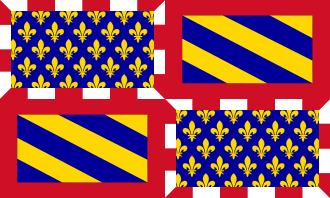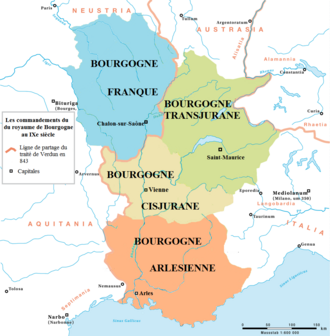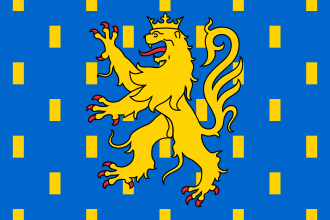Burgundy Last Name Origin, History, and Meaning
Where did the surname Burgundy come from? What does the surname Burgundy mean? Discover the history and meaning of the last name Burgundy and family migration on YourRoots Map.
Surname Burgundy Origin: What does the last name Burgundy mean?
The surname Burgundy has its origins in France, specifically in the historical territory and former administrative region of Burgundy. It is derived from the Burgundians, an East Germanic people who migrated westward beyond the Rhine during the late Roman period. The name Burgundy has been associated with various political entities throughout history, emerging in the 9th century as a successor to the ancient Kingdom of the Burgundians. The surname remained closely linked to France from the 5th to the 14th century, with records also indicating its presence in countries like Spain, showcasing its global spread over the centuries.
YourRoots data confirms the surname Burgundy's early appearance in France in the early 5th century, reflecting its association with the region over time. By the 20th century, the volume of records with the Burgundy surname significantly increased in France, where it remains prominent. The surname has also been found in countries like Spain, indicating its widespread presence internationally. The Burgundy surname's rich history and global distribution highlight its enduring legacy and continued significance in various regions and cultures.
Burgundy Last Name History: Where did the last name Burgundy come from?
Origin of Burgundy Surname: Where does the last name Burgundy originate from?
According to YourRoots data, the surname Burgundy first appeared in records from France around the early 5th century. Please note that this reflects only YourRoots data for the exact Burgundy spelling and does not include other record sources or surname variations.
History of the Last Name Burgundy: What does the Burgundy surname history look like in the early days?
The Burgundy surname remained closely associated with France from the 5th to the 14th century. YourRoots data also shows Burgundy family records in countries like Spain, indicating global spread over the centuries.
Global Spread: Where can we find the Burgundy surname today?
By the 20th century, the volume of records with the Burgundy surname grew significantly in France. The Burgundy surname remains prominent in France. It appears in many countries, including Spain.
Explore Burgundy last name heritage and Burgundy surname origin based on YourRoots Map data
 VIEW THE ORIGIN OF SURNAME BURGUNDY
VIEW THE ORIGIN OF SURNAME BURGUNDYFamous People With Burgundy Surame?

Mary of Burgundy
Mary of Burgundy (Feb 13, 1457 – Mar 27, 1482) was a member of the House of Valois-Burgundy who ruled the Burgundian lands from 1477 until her death. Nicknamed "the Rich," she inherited the lands at 19 and married Maximilian of Austria to protect them from French king Louis XI. This marriage changed the dynasty to Habsburg and led to a French–Habsburg rivalry. Her son became King Philip I of Castile, and her daughter, Margaret, became Duchess of Savoy. Mary's reign was marked by political challenges and attempts by France to claim her territories, but she fiercely defended the Burgundian lands.

Duchy of Burgundy
The Duchy of Burgundy (9th century) was a powerful territory in medieval Europe, stemming from the Kingdom of the Burgundians. It was ruled by the House of Burgundy, a branch of the Capet dynasty, and later the Valois-Burgundy family. The duchy expanded to the Burgundian Netherlands under Duke Philip and reached its peak under Duke Charles the Bold. After his death in the 1477 Battle of Nancy, the duchy was absorbed into the French crown lands. The Burgundian State was one of the largest ducal territories in Early Modern Europe, known for its cultural and political influence across the region.

Kingdom of Burgundy
Kingdom of Burgundy (411–534)
The Kingdom of Burgundy was a historical entity centered in the region of Burgundy during the Middle Ages. Named after the Germanic tribe of Burgundians, the kingdom existed in various forms, including Upper and Lower Burgundy and Provence. The Burgundians settled in Roman Gaul and expanded their domain, facing conflicts with neighboring kingdoms. The decline of the kingdom began when they were attacked by their former Frank allies, leading to their annexation by the Frankish Empire in 534.
Merovingian Burgundy (534–751)
Following the annexation of the Kingdom of Burgundy by the Frankish Empire, Burgundy remained as one of the main polities within the Frankish realm. Several rulers of the Merovingian dynasty used the title "King of Burgundy" between 561 and 737.
Carolingian Burgundy (751–879)
After the partitions of Charlemagne's empire, a short-lived kingdom of Middle Francia was created in 843, including lands from the North Sea to southern Italy. The northwestern part of the former Burgundian lands became the Duchy of Burgundy within the kingdom of West Francia. Conflicts arose as different Carolingian rulers viewed themselves as the true heirs of Middle Francia, leading to power struggles and interventions in the

Duke of Burgundy
The Duke of Burgundy (Duke of Burgundy) was a title used by the rulers of the Duchy of Burgundy from 843 to 1477. Members of the House of Habsburg also held this title, including Holy Roman Emperors and kings of Spain. The Duchy of Burgundy was a small portion of the traditional lands of the Burgundians west of the river Saône. The title passed to Habsburg monarchs after Mary of Burgundy married Maximilian I of Austria in 1477. The Habsburgs used this connection to claim Burgundy proper and ruled their Burgundian inheritance until the Napoleonic era. The title was later revived for younger sons of the House of Bourbon and continues to be used as a courtesy title by some branches.

County of Burgundy
The Free County of Burgundy (French: Franche Comté de Bourgogne; German: Freigrafschaft Burgund) was a medieval feudal state ruled by a count from 982 to 1678. It bordered the Duchy of Burgundy and was part of the Holy Roman Empire. The county gained independence in the 12th century before being re-incorporated into the empire. It fell under the increasing influence of France and the House of Burgundy, later transferred to the House of Habsburg, and eventually conquered by France in 1674. The county's largest city was Besançon, which held the status of a free imperial city.
All images displayed on this page are sourced from Wikipedia or Wikimedia Commons.We use these images under their respective Creative Commons or public domain licenses. Wherever applicable, author attributions and license information are provided. If you believe an image is used incorrectly or outside its license terms, please contact us so that we can review and correct the issue.




.png)